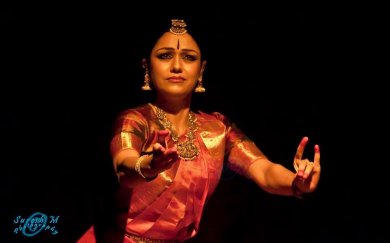 |
|
 |
|
Rama Vaidyanathan at Shanmukhananda - Sanjukta Wagh e-mail: sanjuktawagh@gmail.com Photo: Suresh Muraleedharan December 7, 2014  Rama Vaidyanathan performed at the Shanmukhananda Auditorium in Mumbai
on November 17, 2014. She entered as Krishna the cowherd and then like
the metaphor of Gopal leading his bhaktas, went on to lead the
spectators at Shanmukhananda to bliss. In the seamless flow of the
nritta and abhinaya that followed, one of the high points of the
performance was the varnam where the dootika repeatedly asks her lord to
visit her sakhi in countless nuanced ways. The soulful abhinaya was
interspersed with intricate jatis and rhythms with taut postures and
chiselled movements, energetic jumps, alternating stillness and flow.
Rama went on to portray a refreshingly radical nayika in the
Ninda-stuthi who speaks to the lord with unabashed bluntness. In the
piece that followed, Yashoda pleading with Krishna to reveal his face in
three different contexts was telling of the intent behind choreographic
interpretation that can only come from a deeply internalized Krishna
consciousness. What stood out was the moments of humour deliberately
inserted with a mere glance or gesture leaving the spectators delighted.
The joy and ease in her articulation in both words and dance was
contagious. The performance finale Shivoham demonstrated the power in
the dancing body to defy its own boundaries with "Angikam Bhuvanam
Yasya" embodied. Rama Vaidyanathan performed at the Shanmukhananda Auditorium in Mumbai
on November 17, 2014. She entered as Krishna the cowherd and then like
the metaphor of Gopal leading his bhaktas, went on to lead the
spectators at Shanmukhananda to bliss. In the seamless flow of the
nritta and abhinaya that followed, one of the high points of the
performance was the varnam where the dootika repeatedly asks her lord to
visit her sakhi in countless nuanced ways. The soulful abhinaya was
interspersed with intricate jatis and rhythms with taut postures and
chiselled movements, energetic jumps, alternating stillness and flow.
Rama went on to portray a refreshingly radical nayika in the
Ninda-stuthi who speaks to the lord with unabashed bluntness. In the
piece that followed, Yashoda pleading with Krishna to reveal his face in
three different contexts was telling of the intent behind choreographic
interpretation that can only come from a deeply internalized Krishna
consciousness. What stood out was the moments of humour deliberately
inserted with a mere glance or gesture leaving the spectators delighted.
The joy and ease in her articulation in both words and dance was
contagious. The performance finale Shivoham demonstrated the power in
the dancing body to defy its own boundaries with "Angikam Bhuvanam
Yasya" embodied.In the contemporary critique of classical traditions one says that classical dancers give away the whole story before the performance by talking about it and leave little to the imagination of the spectator. I found myself thinking the same at one point when Rama spoke beautifully about the nayika in the ninda-stuti, about each line and her interpretation. I thought I had already experienced the poem as she had interpreted it and wondered what else the dance would bring out. But to my amazement, knowing what to expect led me to enjoy each nuanced moment especially when her subtext added to or digressed away from what had been said. Not burdened with trying to interpret the "what" I was connected with the "how" of each living moment in her dance interpretation. And yet there was room for moments of multiple interpretations with three different spectators convinced in their post- performance discussion that what the nayika offered to her sakhi was wine, water and milk respectively. In our traditional ways of seeing and listening, the experience is not so much the individual act of making meaning but a united collective consciousness: the satvika experience where boundaries between the rasika, the artiste, and the space are blurred. I think one must be sensitive to this in our own sometimes eurocentric critique of the Indian performing arts. I came away from the performance feeling blessed and humbled by this great ocean of living knowledge that is Indian classical dance. Sanjukta Wagh is a Kathak dancer based in Mumbai. |